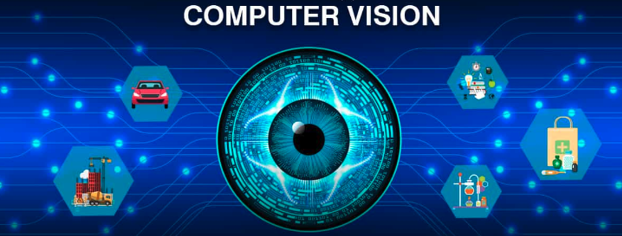Applications of Computer Vision: Business Growth Beyond Imagination

Because of current technology, the innovations we once believed were simply dreams are now possible. Computer vision is among the sophisticated instruments on this list for predicting industrial change.
In computer vision, artificial intelligence informs computers how to analyze and understand their visual surroundings. Computer vision’s main areas of interest are the theory and technology behind building artificial systems, including crucial information from images or multi-dimensional data. Based on this information, recommendations or actions will be made.
In many sectors, the applications of computer vision have proven effective, especially for detailed image analysis, monitoring, and identifying gaps to rectify them. This blog discusses image analysis and the practical applications of computer vision, so read on to learn more.
What is Computer Vision, and How Does it Work?
Artificial Intelligence is the domain that includes Computer Vision. It is the branch of technology that gives computers the ability to see and comprehend their surroundings. Computer vision receives input from images and videos as the human eye does. Artificial intelligence and algorithms are used in computer vision to interpret visual data.
Usually, the procedure begins with capturing images, when visual data is recorded using cameras and videos. Next, to improve the image quality, this data is preprocessed using techniques including noise reduction, normalization, etc. Convolutional Neural Networks (CNNs), in particular, are sophisticated algorithms frequently used to classify and detect things effectively.
Computer vision aims to use AI and robust computer programs to mimic and enhance human visual perception. It analyzes and interprets digital photos and videos quickly and accurately using various image processing methods, deep neural networks, and machine learning.
Image Analysis Using Computer Vision
Computer vision can swiftly and effectively extract pertinent data from images using computational techniques.
The following is the standard process for photo analysis with computer vision technologies:
- Processing the Image
Images are processed to enhance key features and improve quality in preparation for additional processing. The steps in the typical process are as follows:
– Firstly, the image is reduced via grayscale conversion, which helps to streamline the analysis by removing the requirement for color processing.
– Next, filters like noise reduction are employed to smooth out the image and eliminate any potential interference with the analysis.
– The last stage is normalizing the image and modifying the pixel intensity for uniformity.
2. Extracting Features
The process of recognizing and separating an image’s different qualities or traits is known as feature extraction. Features could be particular patterns, colors, textures, or forms. The accuracy and efficiency of the following stages of the analysis are directly impacted by the performance of the feature extraction process, making it crucial.
3. Segmentation
Segmentation divides an image into several parts to simplify and clarify its representation. It uses predefined criteria and involves:
– Dividing the image into areas
– Finding borders by detecting edges
– Clustering pixels
4. Analysis and Interpretation
The system examines changes over time after identifying and categorizing things. Finding patterns or anomalies in the image helps achieve this. Statistics such as size distribution and object counts are also computed by statistical analysis.
5. Decision Making
The last stage is making decisions based on the data analysis. This might be as simple as sending out an alert when a specific object is found or as complex as offering medical imaging diagnostic information.
Applications of Computer Vision in Different Industries
Computer vision is in high demand across many industries, which aligns with the growing need for AI and related technologies. The applications of computer vision have been made by numerous businesses, including retail, security, healthcare, and the automotive sector, which have had a significant impact.
Here are a few of the most widely used computer vision applications:
1. Computer Vision in Healthcare
– X-ray Examination
Medical X-ray imaging can benefit from the successful application of computer vision. While most medical professionals still favor human X-ray image interpretation for illness diagnosis and treatment, computer vision can automate this process more accurately and quickly. A cutting-edge image recognition system can find patterns in an X-ray image that are too faint for human eyes.
– MRI and CT Scan
Computer vision is now widely used in MRI and CT image analysis. AI combined with computer vision creates a system that analyzes radiology images as accurately as a human physician, speeding up the process of identifying diseases and increasing the likelihood of saving a patient’s life. Additionally, it has deep learning algorithms that improve patient outcomes by increasing the resolution of MRI images.
2. Computer Vision in Manufacturing
– Building 3D Models
Using software, create a 3D digital representation of any item or surface. This process is known as 3D model construction or 3D modeling. In this case, computer vision is also helpful for creating 3D computer models from real-world objects. Moreover, 3D modeling has wide-ranging applications in robotics, autonomous vehicles, AR/VR, 3D tracking, and scene reconstruction.
– Identifying Defects
This could be the most popular use of computer vision. Until now, trained individuals have identified flaws in specific batches, and complete manufacturing control is typically unachievable. Computer vision allows us to identify material deficiencies smaller than 0.05mm, such as paint flaws, metal fissures, faulty printing, etc.
3. Computer Vision in Agriculture
– Autonomous Weeding
An intelligent project using AI and computer vision capabilities, an automatic weeding machine removes weeds and undesired plants surrounding crops. Traditional methods are more expensive and inefficient than automatic weeding systems because they involve human labor.
Thanks to computer vision, robots can now detect and remove weeds intelligently, lowering expenses and guaranteeing higher harvests.
– Monitoring the Crops
Crop and yield monitoring is the most crucial responsibility for improving agriculture in the agricultural sector. Traditionally, it has relied on human judgment, which is subjective and not necessarily reliable. Computer vision systems provide real-time agricultural surveillance and the identification of crop variations caused by diseases or nutritional deficiencies.
4. Transportation Computer Vision
– Tracking Road Conditions and Identifying Defects
Moreover, computer vision has been used to track changes in tar and concrete and monitor the state of the road infrastructure. By automatically detecting pavement degradation, a computer vision-enabled system successfully improves the efficiency of road repair allocation. It lowers the likelihood of traffic accident-related accidents.
CV algorithms gather visual data, process it, and produce an automated crack detection and classification system to monitor the state of the road.
– Autonomous Vehicles
Computer vision is extensively used in automated vehicles. It is essential in developing autonomous cars and is utilized for motion estimates, 3D mapping, object detection, and classification (e.g., traffic lights and road signs).
Conclusion
With its novel approach to capturing and analysis, computer vision has become a significant field in medical technology. Today’s technology successfully harnesses it, allowing computers to perceive and comprehend their environment. Numerous industries see tremendous advancements because of AI and ML. One can advance in one’s field through the appropriate applications of computer vision services.
Computer vision is moving forward steadily, fostering collaboration to uncover innovations.







